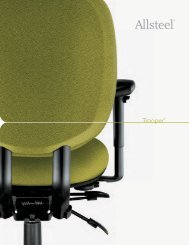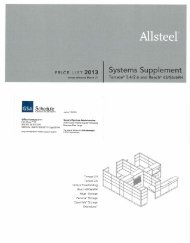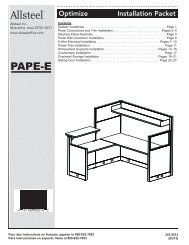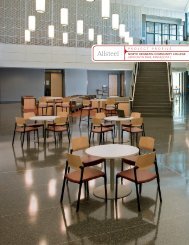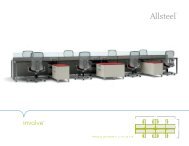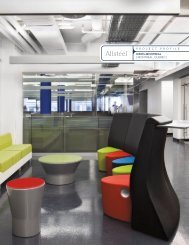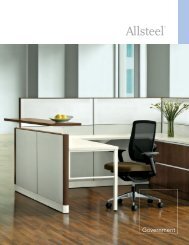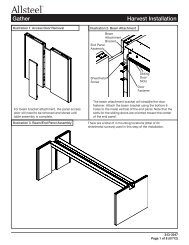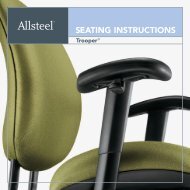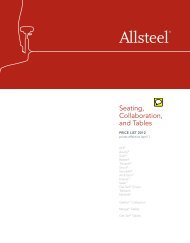The 2008 Workplace Survey - Gensler
The 2008 Workplace Survey - Gensler
The 2008 Workplace Survey - Gensler
You also want an ePaper? Increase the reach of your titles
YUMPU automatically turns print PDFs into web optimized ePapers that Google loves.
Continued<br />
exploration<br />
<strong>Gensler</strong> undertook a two-part initiative to understand how the<br />
<strong>2008</strong> <strong>Workplace</strong> <strong>Survey</strong> findings resonated with our client partners<br />
and within our own design teams.<br />
Client Roundtables<br />
<strong>Gensler</strong> conducted a series of roundtable discussions with<br />
our clients and staff where we presented survey findings and<br />
engaged in conversations about key ideas. Overwhelmingly,<br />
our clients acknowledged that knowledge economy work<br />
practices have changed but that many organizations have not<br />
recognized the full potential in these changes—essentially,<br />
they are prolonging workplace practices that conflict with<br />
new realities.<br />
<strong>The</strong>re was virtually universal agreement that collaboration<br />
is the paramount discipline to master in knowledge work, and<br />
that creating effective collaboration work spaces is equally as<br />
difficult. High amounts of collaboration are happening in<br />
primary work areas that were created for focus mode, disrupting<br />
the effectiveness of those spaces.<br />
Roundtable participants agreed that learning at work has<br />
to move from an isolated, abstract activity to an inherent<br />
part of everyday work life, and that design plays a key role<br />
in enabling this improvement. Perhaps the strongest<br />
client response was around the increasing importance of<br />
socializing in the workplace. Clients cited staff retention,<br />
communication and innovation as critical outcomes of<br />
this work mode.<br />
design charrettes<br />
<strong>Gensler</strong> is conducting an ongoing series of design charrettes<br />
in the U.S. and U.K. in response to our survey findings.<br />
We asked more than 300 designers across the firm to create<br />
the different kind of workplace implied by our survey<br />
findings. Ideas have been both pragmatic and highly inventive,<br />
providing many new concepts that we can use to inform<br />
real-life client situations. Future papers and online features<br />
will explore these ideas in greater depth.<br />
research at gensler<br />
<strong>Gensler</strong>’s <strong>Workplace</strong> <strong>Survey</strong> series represents a continuum<br />
of efforts where each report builds on the research and<br />
findings of previous surveys. To this point, surveys have<br />
focused on the U.S. and U.K.; future initiatives will cover Asia<br />
and other markets. <strong>Survey</strong> methodologies are aligned for<br />
comparative analysis purposes.<br />
2005<br />
Findings from <strong>Gensler</strong>’s 2005 U.K. <strong>Workplace</strong> <strong>Survey</strong> showed<br />
that workplace design is a significant factor to workers,<br />
and revealed that nearly 60% of the U.K. workers surveyed<br />
felt that their spaces did not reflect or support their job<br />
function or creativity. In addition, the survey discovered<br />
the potential for a 19% increase in productivity through<br />
higher-performance spaces. This percentage increase translated<br />
into roughly £137 billion pounds—about $277 billion<br />
in U.S. dollars—in overall lost profit each year.<br />
2006<br />
<strong>The</strong> 2006 U.S. <strong>Workplace</strong> survey revealed that the workplace<br />
is a significant factor to U.S. workers, with 9 in 10 reporting<br />
that workplace affects their productivity. Respondents reported<br />
a 21% potential increase in productivity if spaces were better<br />
designed, translating into $377 billion in lost opportunity<br />
each year. <strong>The</strong> 2006 U.S. survey findings were combined<br />
with focus group-based perspectives of more than 100<br />
real estate and facilities decision-makers, leading to the<br />
identification of four primary workplace drivers: diversity,<br />
distance, corporate responsibility and work modes.<br />
methodology<br />
This report’s findings are based on an original survey designed<br />
by <strong>Gensler</strong> in collaboration with independent research firm<br />
Added Value, a subsidiary of WPP.<br />
<strong>Survey</strong> Sample<br />
<strong>The</strong> <strong>2008</strong> <strong>Workplace</strong> <strong>Survey</strong> was conducted with a national,<br />
random sample of 900 full-time, in-office workers—defined<br />
as workers who spend most of their time working at a primary,<br />
assigned location. Respondents covered all staff levels with<br />
equal distribution across the continental United States. <strong>The</strong><br />
study included respondents from specific industries including:<br />
banking, finance, insurance, technology, internet, telecom,<br />
consumer products, retail, legal, accounting, consulting,<br />
energy, media, creative, entertainment, and not-for-profit<br />
associations.<br />
<strong>Survey</strong> Questions<br />
We developed questions to place data about the physical<br />
work environment in a larger business and workplace<br />
context, looking for:<br />
• Evaluation of company business success based on eight<br />
established indicators: leadership in their industry; financial<br />
strength; creation of quality products or services; innovation;<br />
promotion of work/life balance; superior management<br />
capabilities; ability to attract and retain talent; responsibility<br />
to community and environment 21<br />
• <strong>The</strong> company’s profit and revenue growth<br />
• Perceptions of the workplace in relation to company<br />
values, brand and performance<br />
• Evaluation of physical workplace factors<br />
32<br />
<strong>Gensler</strong> <strong>2008</strong> <strong>Workplace</strong> <strong>Survey</strong> / United States<br />
<strong>Gensler</strong> <strong>2008</strong> <strong>Workplace</strong> <strong>Survey</strong> / United States<br />
33




